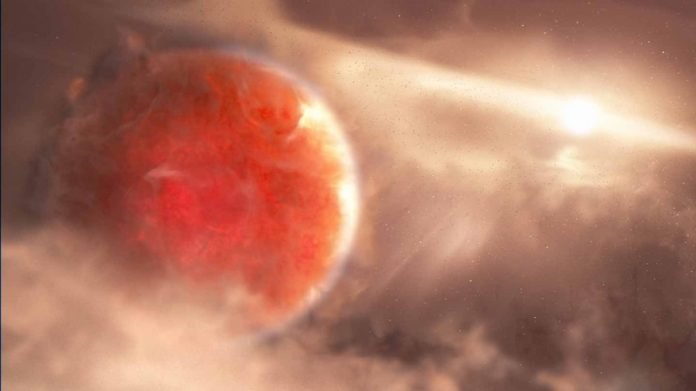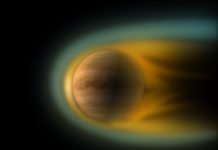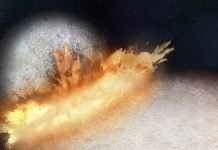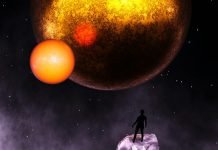
Astronomers have discovered evidence of a giant planet in the process of forming.
This provides the first-ever look at the earliest stages of the formation of a gas giant planet, when it’s still embedded in the disk of gas and dust surrounding its young host star.
The findings offer evidence for a long-debated alternative theory for how Jupiter-like planets form: through an “intense and violent” breakup of the protoplanetary disk, according to the authors.
The dominant theory believed to underlie the formation of giant gas planets is called “core accretion“—a bottom-up process in which planets embedded in a disk of gas and solids grow from smaller objects, ranging from dust- to boulder-sized, colliding and sticking together as they orbit a star.
This core then slowly accretes gas. In contrast, “disk instability” is a top-down process in which a massive, gaseous protoplanetary disk cools, and gravity causes the disk to rapidly break up into one or more planet-mass fragments.
Located 505 light-years from Earth, AB Aurigae is a fairly young star estimated to be around 2 million years old, about the age of our solar system when planet formation was underway.
The newly forming planet, dubbed AB Aurigae b, is probably about nine times more massive than Jupiter and orbits its host star at a whopping distance of 8.6 billion miles—about twice the distance between the sun and Pluto.
At that distance, Aurigae b is highly unlikely to be the product of core accretion, the authors write, and a breakup of AB Aurigae’s protoplanetary disk better explains its origin.
Planet-forming disks around stars are not featureless blobs but can have cavities, gaps, or regions where different densities produce spiral waves.
Such features are very faint, and to detect them, astronomers need sophisticated instruments and techniques such as coronagraphs—telescope attachments designed to block the glare from the host star—and complex image processing algorithms.
Researchers had to figure out how to distinguish between a true planet and structural features resulting from the disk being distorted, corrupted, or reshaped in some way, and residual artifacts after image processing.
Nature itself also provided a helping hand—the vast disk of dust and gas swirling around the star AB Aurigae is tilted nearly face-on to our view from Earth.
Hubble’s longevity played an important role in helping researchers measure the protoplanet’s orbit, says lead author Thayne Currie, an astrophysicist with the Subaru Telescope.
He was originally skeptical that AB Aurigae b was a planet. The archival data from Hubble, combined with imaging from Subaru, helped change his mind.
“We could not detect this motion on the order of a year or two years,” he says. “Hubble provided a time baseline, combined with Subaru data, of 13 years, which was sufficient to be able to detect orbital motion.”
Gas giant formations
Combining Hubble’s visible-light instrument, called STIS, and near-infrared instrument, called NICMOS—each outfitted with a coronagraph—provided the necessary one-two punch, says coauthor Glenn Schneider, emeritus research professor of astronomy at the University of Arizona’s College of Science’s Steward Observatory.
“New, optimally designed STIS imaging unambiguously allowed us to disentangle light emitted by the disk and the planet from the background ‘pollution’ of residual starlight and create visible-light images of the highest fidelity,” he says.
“NICMOS, with much improved reprocessing of near-infrared data obtained 13 years earlier, provided us with the time baseline needed to study planetary motion in the disk.”
The Subaru Telescope’s SCExAO exoplanet imaging system further helped the team distinguish a protoplanet buried in a disk from a small structural feature in the disk itself.
“Subaru Telescope’s extreme adaptive optics pulled AB Aur b’s image from the bright structured disk surrounding the star, allowing our infrared and visible instruments to then confirm its nature,” says Olivier Guyon, an astronomer at Steward Observatory and professor at the University of Arizona’s College of Optical Sciences who serves as the principal investigator of the SCExAO instrument.
Kevin Wagner, a NASA Hubble/Sagan Fellow at Steward Observatory, played a key role in disentangling the various different possibilities of disk structures masquerading for planets and building robust evidence for the presence of a giant planet.
“The spiral arm features we observed in this disk are just what we should expect if we have a planet with the mass of Jupiter or more in the presence of these dust structures,” Wagner says. “A massive planet should perturb them into exactly like what we are seeing here.”
The effort “sheds new light on our understanding of the different ways that planets form,” Currie says.
“It really took an accumulation of evidence from the ground and from space before we reached the conclusion that this was actually a planet,” Currie says.
Understanding the early epochs of the formation of Jupiter-like planets provides astronomers with more context for the history of our own solar system.
This discovery paves the way for future studies of the chemical makeup of protoplanetary disks like AB Aurigae, including study with NASA’s James Webb Space Telescope.




